| |
|
|
|

|
| |
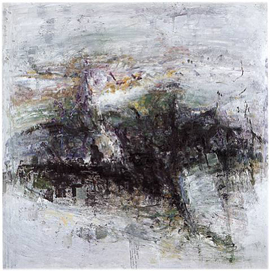 Karel Dierickx, Die unsichtbare Zeit, 1995
Karel Dierickx, Die unsichtbare Zeit, 1995 |
|
Born in Ghent in 1940, Karel Dierickx is a painter, sculptor and draftsman. Dierickx has been persistently working for decades on a coherent oeuvre. His work tends between abstraction and figuration and fascinates through its highly artistic intensity. Whatever medium he uses — painting, sculpture, drawing or etching — hidden in each work is a vulnerable longing for timelessness.
In his work Karel Dierickx constantly observes the never ending process of decay and death, and creates his very own, suggestive universe trough rather traditional subjects, including landscape, interior, still life, and the human figure. Dierickx does not so much depict the rich variety of forms and subjects realistically, but rather recreates them pictorially out of lines and strokes. The object, the motif, loses its interpretability, thus liberating one’s vision for direct contemplation of the drawing itself.
In his etchings, Karel Dierickx alludes to his own drawings, translating them to the medium of print. In the studio of master printer Henri Hemelsoet, he acquired a broad range of etching techniques, ranging from soft-ground etching (vernis mou), sugar lift aquatint and intaglio engraving.
For Giotto's hemel (Giotto’s heaven), Dierickx was inspired by early Renaissance sinopia drawings. [1]
|
| |
|
|

In 2012 Ergo Pers will publish Giotto's hemel (Giotto's heaven), a livre de peintre with poetry by Stefan Hertmans and etchings by the Flemish painter and draftsman Karel Dierickx.[1] Dierickx created a series of etchings inspired by early Renaissance sinopia drawings, in response to Hertmans' poems about Giotto, Piero della Francesca, Luca Signorelli and Fra Angelico.
|
| |
|
|
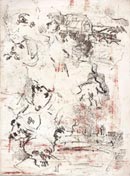 |
|
|
| |
|
|
|
|
|
| |
|
|
Negen slapeloze gedichten | Neun schlaflose Gedichte, a limited edition artist's book, with poetry by Leonard Nolens.
Ergo Pers 2006, five etchings signed and numbered by the artist.
Negen slapeloze gedichten | Neun schlaflose Gedichte, bilingual edition (Dutch-German) of 60 copies. 28 x 35 cm, 44 bladzijden. 750 Euro’s.
|
| |
|
|
|
| |
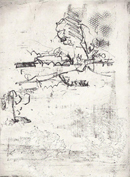
Karel Dierickx, etching for Negen
slapeloze gedichten, Ergo Pers, 2007
|
|
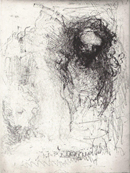 |
|
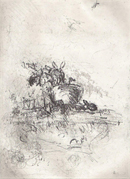 |
| |
|
|
|
|
| |
|
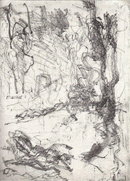 |
|
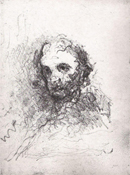 |
| |
|
|
 |
| |
|
|






|
| |
|
|
Die ungewisse Dauer, Münster 2003
Karel Dierickx. neue Bilder und Skulpturen, Zürich, Galerie Arteba
Vuurwerk zei ze, Gent, 2002
Der verlorene Blick. der Kopf in Skulptur, Zeichnung und Bild, Zürich, Galerie Lelong, 2001
Karel Dierickx in de verzameling Lohmann-Hofmann. Karel Dierickx dans la collection Lohmann-Hofmann. Werken op papier. Oeuvres sur papier. Münster, Hachmeister Galerie, 2001
Der unabwendbare Abschied, Münster, 1998
Malerei und Zeichnungen 1995/96, met tekst van Stefan Hertmans, Münster, Hachmeister Galerie, 1996
Signaturen, Gent, SMAK - Stedelijk Museum voor Actuele Kunst, 1988
Karel Dierickx, Antwerpen, ICC - Internationaal Cultureel Centrum, 1985
Biennale di Venezia Comunità Fiamminga del Belgio. Luc Deleu, Karel Dierickx, José Vermeersch, Jan Fabre, Jan Vanriet. Brussel, 1984
Giotto's hemel. Poetry. Artists' book with poetry by Stefan Hertmans and etchings by Karel Dierickx. Ergo Pers, 2012. |
| |
|
|

Karel Dierickx, (1940, Ghent) lives and works in Ghent | website | www.kareldierickx.be
Galerie HACHMEISTER in Münster.
|
| |
|
|
|
| |
|
|
 |
| |
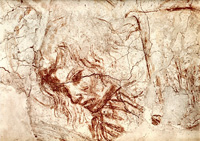
Buonamico Buffalmacco, sinopia
drawing in Campo Santo, Pisa
|
|
[1] A sinopia is the underdrawing for fresco made with reddish, greenish or brownish earth colour, brushed on the arriccio layer, over which the intonaco is applied before painting.
Sinopia takes its name from Sinop, a cape and port town on Turkey's Black Sea coast.
A drawing called a sinopia is often sketched directly onto the rough plaster that will eventually be covered with the final painting layer. Sinopia drawings serve as a guide for the last layer of plastering, particularly when the composition is large, requiring several sections of plaster. They allows the painter to see the whole composition of the wall while painting a small section of it. And they are the final step in the design of the fresco, enabling the painter to see it in relation to the rest of the church. |
| |
|
|
|
 |
|

|
| |
copyright © ergo pers | some rights reserved |
|
site design by Zeuxis
|
|
